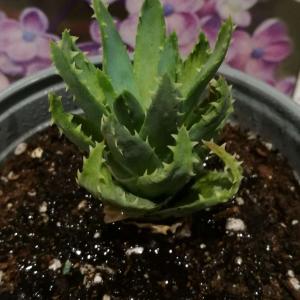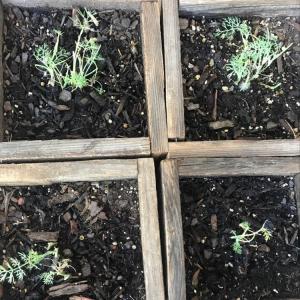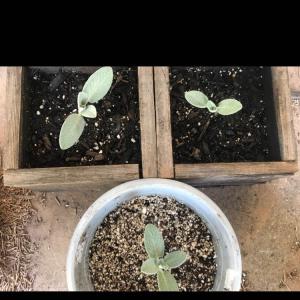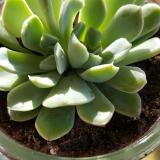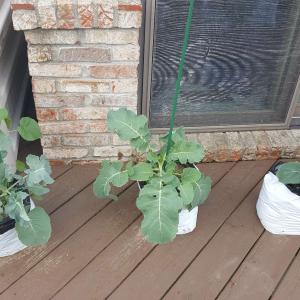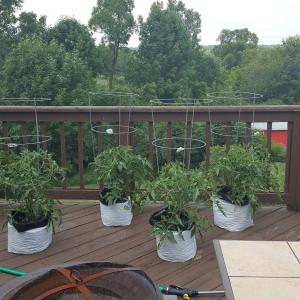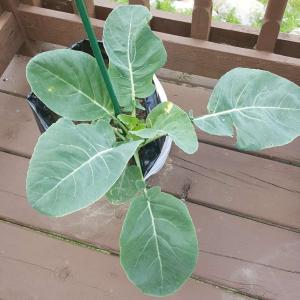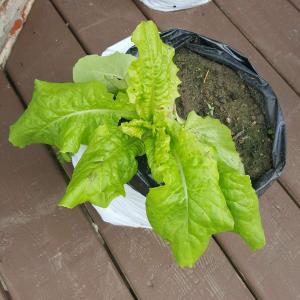文章
Dummer. ゛☀
2017年07月12日

Family - Caprifoliaceae
Stems - Woody, single or more commonly multiple from base, to +/-3m tall, branching. Twigs stellate pubescent. New seasons growth dense stellate pubescent.
Leaves - Opposite, petiolate, serrate-dentate to crenate-serrate, elliptic to ovate or orbicular, acute to abruptly acuminate at apex, stellate pubescent above, densely stellate pubescent below, to +/-10cm long, +/-8cm broad. Petiole +/-3cm long, stellate pubescent, reddish.
Inflorescence - Multiple flat-topped umbellate cymes secund on branches, terminal on new seasons growth. Peduncles to 4cm long, dense stellate pubescent.
Flowers - Outer flowers large, white, sterile, 5 lobed, zygomorphic, to -3cm broad. Inner flowers perfect, 5-lobed, whitish, to 5mm broad. Corolla lobes glabrous. Stamens 5, alternating with corolla lobes, adnate at base of corolla tube, exserted. Filaments to -2mm long, white, glabrous. Anthers .5mm long, yellow. Ovary inferior. Calyx tube 1mm long, 5-lobed. Lobes whitish-green, glabrous.
Fruits - 7mm long, elliptic to subglobose, red at first and maturing to black, single-seeded, drupes.
Flowering - May - July.
Habitat - Cultivated.
Origin - Native to Asia.
Other info. - This is a heavily cultivated species with many varieties. I believe the plant pictured above is var. tomentosum. The plant is one of the most showy of all the shrubs and is considered the most desirable of the genus for cultivation. It will set fruit if plants are in close proximity with one another.
Stems - Woody, single or more commonly multiple from base, to +/-3m tall, branching. Twigs stellate pubescent. New seasons growth dense stellate pubescent.

Leaves - Opposite, petiolate, serrate-dentate to crenate-serrate, elliptic to ovate or orbicular, acute to abruptly acuminate at apex, stellate pubescent above, densely stellate pubescent below, to +/-10cm long, +/-8cm broad. Petiole +/-3cm long, stellate pubescent, reddish.

Inflorescence - Multiple flat-topped umbellate cymes secund on branches, terminal on new seasons growth. Peduncles to 4cm long, dense stellate pubescent.
Flowers - Outer flowers large, white, sterile, 5 lobed, zygomorphic, to -3cm broad. Inner flowers perfect, 5-lobed, whitish, to 5mm broad. Corolla lobes glabrous. Stamens 5, alternating with corolla lobes, adnate at base of corolla tube, exserted. Filaments to -2mm long, white, glabrous. Anthers .5mm long, yellow. Ovary inferior. Calyx tube 1mm long, 5-lobed. Lobes whitish-green, glabrous.
Fruits - 7mm long, elliptic to subglobose, red at first and maturing to black, single-seeded, drupes.
Flowering - May - July.
Habitat - Cultivated.
Origin - Native to Asia.
Other info. - This is a heavily cultivated species with many varieties. I believe the plant pictured above is var. tomentosum. The plant is one of the most showy of all the shrubs and is considered the most desirable of the genus for cultivation. It will set fruit if plants are in close proximity with one another.
0
0
文章
Dummer. ゛☀
2017年07月12日

Family - Caprifoliaceae
Stems - Woody, multiple. A shrub to 5m tall. Twigs appearing somewhat glaucous but actually glabrous. New seasons growth glabrous, 5(6)-angled, with longitudinal grooves.
Leaves - Opposite, petiolate, typically rounded but sometimes slightly cordate at base, toothed, orbicular to broadly-ovate, to 7.5cm long, lower surface dull green with tufts of hairs mostly in vein axils or on veins, upper surface shiny deeper green, glabrous.
Inflorescence - Terminal, compound cymes (resembling compound umbels), to +13cm broad. Pedicles glabrous or with ferruginous stalked and sessile glands. Small scarious bracts present at base of each division of inflorescence.
Flowers - Corolla white, 4-5mm broad, 5-lobed, glabrous internally or with very few sparse hairs, glabrous externally, tube to 1.2mm long, 2-3mm broad, campanulate. Stamens 5, well exserted, alternating with corolla lobes. Filaments to 4mm long, white, glabrous, borne at base of corolla tube. Anthers yellow, .6mm long. Calyx tube to 2mm long, 1mm broad, cylindric, glabrous, 5-lobed. Lobes greenish-white, very small, tuberculate.
Flowering - May - June.
Habitat - Low alluvial woods on terraces and wooded slopes. Widely cultivated.
Origin - Native to U.S.
Other info. - This plant is just one of the many species in this genus cultivated in Missouri. The plant can be identified by its suborbicular, dentate leaves (which have deeply impressed lateral veins).
Natives used the wood from the tree to make arrows for hunting. They also used the inner bark as a tobacco substitute.
Stems - Woody, multiple. A shrub to 5m tall. Twigs appearing somewhat glaucous but actually glabrous. New seasons growth glabrous, 5(6)-angled, with longitudinal grooves.
Leaves - Opposite, petiolate, typically rounded but sometimes slightly cordate at base, toothed, orbicular to broadly-ovate, to 7.5cm long, lower surface dull green with tufts of hairs mostly in vein axils or on veins, upper surface shiny deeper green, glabrous.
Inflorescence - Terminal, compound cymes (resembling compound umbels), to +13cm broad. Pedicles glabrous or with ferruginous stalked and sessile glands. Small scarious bracts present at base of each division of inflorescence.

Flowers - Corolla white, 4-5mm broad, 5-lobed, glabrous internally or with very few sparse hairs, glabrous externally, tube to 1.2mm long, 2-3mm broad, campanulate. Stamens 5, well exserted, alternating with corolla lobes. Filaments to 4mm long, white, glabrous, borne at base of corolla tube. Anthers yellow, .6mm long. Calyx tube to 2mm long, 1mm broad, cylindric, glabrous, 5-lobed. Lobes greenish-white, very small, tuberculate.

Flowering - May - June.
Habitat - Low alluvial woods on terraces and wooded slopes. Widely cultivated.
Origin - Native to U.S.
Other info. - This plant is just one of the many species in this genus cultivated in Missouri. The plant can be identified by its suborbicular, dentate leaves (which have deeply impressed lateral veins).
Natives used the wood from the tree to make arrows for hunting. They also used the inner bark as a tobacco substitute.
0
0
文章
Dummer. ゛☀
2017年07月12日

Family - Caprifoliaceae
Stems - To +3m tall, woody, glabrous, erect, branching, multiple from base, with large whitish pith. New growth green, glabrous, often glaucous.
Leaves - Opposite, pinnately compound. Petioles to +6cm long, glabrous, with an adaxial groove. Petiolules to +5mm long. Leaflets typically 5-9 per leaf, glabrous or very sparsely pubescent, oblong to lanceolate, crenate-serrate, to +10cm long, +5cm broad.
Inflorescence - Terminal compound cymes, typically dome shaped to flattened, to 30cm broad.
Flowers - Corolla white, 5-lobed, glabrous, 5-6mm broad. Lobes 2.2mm long, 2mm broad, rounded to emarginate at apex. Stamens 5, adnate at base of corolla tube, alternating with corolla lobes, erect to spreading. Filaments white, glabrous, 2.4mm long. Anthers yellow, .5mm long. Style wanting. Stigma 5-lobed, capitate. Ovary inferior, 4-locular. Calyx tube 1mm long, creamy white, glabrous, 5-lobed. Lobes acute, .5mm long. Fruits blackish-purple, globose, glabrous, to 5mm in diameter, 4-seeded.
Flowering - May - August.
Habitat - Open woods, thickets, waste ground, disturbed sites, fence rows, roadsides, railroads.
Origin - Native to U.S.
Other info. - This species is actually quite aggressive if given the right conditions. It spreads by suckering. The fruits are edible if cooked (boiled) and this plant is the source of the ever popular "Elderberry jelly". The pith of the stems is large, soft, and easily removed and my dad tells childhood stories of making flutes from stems of a similar European species. Don't get too much sap in your mouth though, it's toxic. The plants contain calcium oxalate crystals which do a number on a persons kidneys.
Stems - To +3m tall, woody, glabrous, erect, branching, multiple from base, with large whitish pith. New growth green, glabrous, often glaucous.
Leaves - Opposite, pinnately compound. Petioles to +6cm long, glabrous, with an adaxial groove. Petiolules to +5mm long. Leaflets typically 5-9 per leaf, glabrous or very sparsely pubescent, oblong to lanceolate, crenate-serrate, to +10cm long, +5cm broad.
Inflorescence - Terminal compound cymes, typically dome shaped to flattened, to 30cm broad.
Flowers - Corolla white, 5-lobed, glabrous, 5-6mm broad. Lobes 2.2mm long, 2mm broad, rounded to emarginate at apex. Stamens 5, adnate at base of corolla tube, alternating with corolla lobes, erect to spreading. Filaments white, glabrous, 2.4mm long. Anthers yellow, .5mm long. Style wanting. Stigma 5-lobed, capitate. Ovary inferior, 4-locular. Calyx tube 1mm long, creamy white, glabrous, 5-lobed. Lobes acute, .5mm long. Fruits blackish-purple, globose, glabrous, to 5mm in diameter, 4-seeded.

Flowering - May - August.
Habitat - Open woods, thickets, waste ground, disturbed sites, fence rows, roadsides, railroads.
Origin - Native to U.S.
Other info. - This species is actually quite aggressive if given the right conditions. It spreads by suckering. The fruits are edible if cooked (boiled) and this plant is the source of the ever popular "Elderberry jelly". The pith of the stems is large, soft, and easily removed and my dad tells childhood stories of making flutes from stems of a similar European species. Don't get too much sap in your mouth though, it's toxic. The plants contain calcium oxalate crystals which do a number on a persons kidneys.

0
0
成长记
Ueca
2017年07月12日

I new added a "Rhipsalis pilocarpa" in my "garden"
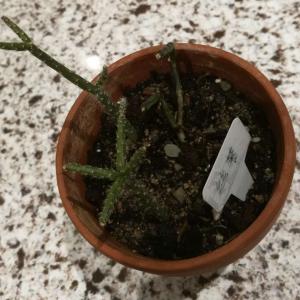

1
0
Ueca:In case you're wondering about the tag, it shows the plant's name, «丝苇», meaning "Silk Reeds". The Chinese names tend to be artsy and intricate (I like to keep them around for reference 😁), while the Latin names are more systematic and sometimes pertain to biological function as well.
文章
Dummer. ゛☀
2017年07月12日

Family - Caprifoliaceae
Stems - Woody, multiple from base. A shrub to +5m tall, erect. New seasons growth tomentose. Twigs tomentose, typically hollow.
Leaves - Opposite, petiolate, simple. Petioles to +/-6mm long, tomentose. Blades ovate-lanceolate, acute to acuminate, entire, to +/-9cm long, +/-4cm broad, typically glabrous adaxially but sometimes with pubescence on midrib, pubescent abaxially especially on veins. Margins ciliolate.
Inflorescence - Axillary pedunculate paired flowers. Peduncles +/-3mm long, pubescent, with a pair of small bracts at the joint in the peduncle. Bracts to 3mm long, linear, ciliate. Pair of bracts subtending the calyx and ovary to 1.7mm long, rounded, ciliate-margined, green, pubescent.
Flowers - Corolla white when fresh, fading to a yellowish-white when older, often with some pinkish tinge at base of tube. Corolla tube to 9mm long, 2-3mm in diameter, tomentose externally, pubescent internally. Corolla bilabiate. Lower lip single-lobed. Lobe to +1.5cm long, 4mm broad, rounded at apex, glabrous internally, tomentose externally. Upper lip 4-lobed. Lobes to +1.5cm long, rounded at apex, pubescent externally, glabrous internally. Stamens 5, exserted, alternating with the corolla lobes, adnate at apex of corolla tube. Filaments to 1.1cm long, pubescent at base, glabrous near apex, white. Anthers yellow, to 6mm long, 1.2mm broad. Style white, 1.6cm long, pubescent, exserted. Stigma green, capitate. Ovary inferior, green, 3-locular, 1.5mm in diameter, sub-globose. Placentation axile. Calyx tube +/-1.5mm long, 5-lobed, pubescent, green. Lobes unequal, shallow, +/-1mm long, acute, greenish-white. Fruits red, 2-4mm in diameter, glabrous, fleshy.
Flowering - April - June.
Habitat - Disturbed sites, thickets, roadsides, railroads, woodland borders.
Origin - Native to Asia.
Other info. - This nasty and aggressive species was brought to North America in 1855 as an ornamental. It has since spread rapidly and is found over much of the eastern half of the U.S. from Kansas east. The berries are eaten by birds which helps the plant spread rapidly. There are other species of bush honeysuckles in Missouri but this is the most aggressive and common.
Stems - Woody, multiple from base. A shrub to +5m tall, erect. New seasons growth tomentose. Twigs tomentose, typically hollow.
Leaves - Opposite, petiolate, simple. Petioles to +/-6mm long, tomentose. Blades ovate-lanceolate, acute to acuminate, entire, to +/-9cm long, +/-4cm broad, typically glabrous adaxially but sometimes with pubescence on midrib, pubescent abaxially especially on veins. Margins ciliolate.

Inflorescence - Axillary pedunculate paired flowers. Peduncles +/-3mm long, pubescent, with a pair of small bracts at the joint in the peduncle. Bracts to 3mm long, linear, ciliate. Pair of bracts subtending the calyx and ovary to 1.7mm long, rounded, ciliate-margined, green, pubescent.
Flowers - Corolla white when fresh, fading to a yellowish-white when older, often with some pinkish tinge at base of tube. Corolla tube to 9mm long, 2-3mm in diameter, tomentose externally, pubescent internally. Corolla bilabiate. Lower lip single-lobed. Lobe to +1.5cm long, 4mm broad, rounded at apex, glabrous internally, tomentose externally. Upper lip 4-lobed. Lobes to +1.5cm long, rounded at apex, pubescent externally, glabrous internally. Stamens 5, exserted, alternating with the corolla lobes, adnate at apex of corolla tube. Filaments to 1.1cm long, pubescent at base, glabrous near apex, white. Anthers yellow, to 6mm long, 1.2mm broad. Style white, 1.6cm long, pubescent, exserted. Stigma green, capitate. Ovary inferior, green, 3-locular, 1.5mm in diameter, sub-globose. Placentation axile. Calyx tube +/-1.5mm long, 5-lobed, pubescent, green. Lobes unequal, shallow, +/-1mm long, acute, greenish-white. Fruits red, 2-4mm in diameter, glabrous, fleshy.

Flowering - April - June.
Habitat - Disturbed sites, thickets, roadsides, railroads, woodland borders.
Origin - Native to Asia.
Other info. - This nasty and aggressive species was brought to North America in 1855 as an ornamental. It has since spread rapidly and is found over much of the eastern half of the U.S. from Kansas east. The berries are eaten by birds which helps the plant spread rapidly. There are other species of bush honeysuckles in Missouri but this is the most aggressive and common.
0
0




